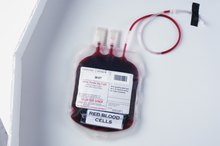Chemoreceptors in the Cardiovascular System
The cardiovascular system, made up primarily of the heart, blood vessels, and blood, is responsible for distributing oxygenated blood to body cells, and removing metabolic waste from the cells. By necessity, function of the cardiovascular system requires close partnership with the respiratory system, which is the source of oxygen.
Chemoreceptors, or chemical-sensing cells, in the cardiovascular system monitor chemical characteristics of the blood to help regulate function of both cardiovascular and respiratory systems 2.
Carbon Dioxide Chemoreceptors
The chemoreceptors of the cardiovascular system are located in two places 2. The carotid bodies are located in the carotid arteries that run through the neck to the brain, and the aortic bodies are found in the aortic arch, an arterial feature near the heart. Some of the most important chemoreceptors detect carbon dioxide, a cellular metabolic waste product. Since one of the major jobs of the cardiovascular system is to get carbon dioxide to the lungs for elimination, buildup of the chemical indicates that the heart needs to work harder to move the blood, and that the lungs need to work harder to exhale the carbon dioxide. Explains Dr. Lauralee Sherwood in her book, "Human Physiology," if chemoreceptors sense high levels of carbon dioxide, both heart rate and breathing rate increase to eliminate the waste product from the blood 12.
Oxygen Chemoreceptors
How to Read Arterial Blood Gases
Learn More
For a long time, researchers thought that chemoreceptors responded to carbon dioxide concentration, but not to oxygen concentration in the blood. In recent years, however, scientists have determined that the chemoreceptors of the carotid and aortic bodies also sense oxygen, which makes sense given that oxygen is crucial to cellular function. Richard Klabunde, Ph.D., on the website Cardiovascular Physiology Concepts, explains that low concentrations of oxygen in the blood activate the chemoreceptors, leading to increased rate of respiration and potentially increased heart rate as well 2.
pH Chemoreceptors
The final chemical of interest to the chemoreceptors in the cardiovascular system is acid 2. In chemistry, the concentration of acid in liquid is measured in pH units, where a pH of 7 is neutral. Acidic liquids have a pH lower than 7, while basic liquids have a pH higher than seven. In his book, "Anatomy and Physiology," Dr. Gary Thibodeau explains that normal human blood pH is 7.4 3. The body works very hard to maintain this pH, since excessively acidic or basic blood doesn't offload oxygen at the cells properly. If chemoreceptors sense low pH, meaning that the blood is acidic, rate of respiration increases. The reason for this is that carbon dioxide, in addition to being a waste product in its own right, also lowers the pH of the blood. Oxygen doesn't affect blood pH. As such, increased respiration rate--resulting in decreased blood carbon dioxide and increased oxygen--increases blood pH, and regulates acidity.
- The final chemical of interest to the chemoreceptors in the cardiovascular system is acid 2.
- The body works very hard to maintain this pH, since excessively acidic or basic blood doesn't offload oxygen at the cells properly.
Related Articles
References
- “Human Physiology”; Lauralee Sherwood, Ph.D.; 2004
- Cardiovascular Physiology Concepts: Chemoreceptors
- “Anatomy and Physiology”; Gary Thibodeau, Ph.D.; 2007
Writer Bio
Kirstin Hendrickson is a writer, teacher, coach, athlete and author of the textbook "Chemistry In The World." She's been teaching and writing about health, wellness and nutrition for more than 10 years. She has a Bachelor of Science in zoology, a Bachelor of Science in psychology, a Master of Science in chemistry and a doctoral degree in bioorganic chemistry.







